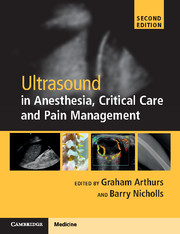Book contents
- Ultrasound in Anesthesia, Critical Care, and Pain Management
- Ultrasound in Anesthesia, Critical Care, and Pain Management
- Copyright page
- Contents
- Contributors
- Preface to the second edition
- Glossary
- Chapter 1 Principles of medical ultrasound
- Chapter 2 Ultrasound to aid vascular access
- Chapter 3 Diagnostic echocardiography
- Chapter 4 The role of echocardiography in the hemodynamically unstable patient in critical care and the operating room
- Chapter 5 Transesophageal diagnostic Doppler monitoring
- Chapter 6 Ultrasound in critical care
- Chapter 7 Ultrasound and airway management
- Chapter 8 The use of ultrasound in the traumatized patient and the acute abdomen
- Chapter 9 The use of ultrasound to aid local anesthetic nerve blocks in adults
- Chapter 10 Ultrasound-guided nerve blocks in children
- Chapter 11 Cranial ultrasound in the newborn
- Chapter 12 The use of ultrasound in acute gynecology and pregnancy assessment
- Chapter 13 Ocular ultrasonography
- Chapter 14 The use of ultrasound in assessing soft tissue injury
- Chapter 15 The use of ultrasound in pain management
- Index
- References
Chapter 9 - The use of ultrasound to aid local anesthetic nerve blocks in adults
Published online by Cambridge University Press: 21 March 2017
- Ultrasound in Anesthesia, Critical Care, and Pain Management
- Ultrasound in Anesthesia, Critical Care, and Pain Management
- Copyright page
- Contents
- Contributors
- Preface to the second edition
- Glossary
- Chapter 1 Principles of medical ultrasound
- Chapter 2 Ultrasound to aid vascular access
- Chapter 3 Diagnostic echocardiography
- Chapter 4 The role of echocardiography in the hemodynamically unstable patient in critical care and the operating room
- Chapter 5 Transesophageal diagnostic Doppler monitoring
- Chapter 6 Ultrasound in critical care
- Chapter 7 Ultrasound and airway management
- Chapter 8 The use of ultrasound in the traumatized patient and the acute abdomen
- Chapter 9 The use of ultrasound to aid local anesthetic nerve blocks in adults
- Chapter 10 Ultrasound-guided nerve blocks in children
- Chapter 11 Cranial ultrasound in the newborn
- Chapter 12 The use of ultrasound in acute gynecology and pregnancy assessment
- Chapter 13 Ocular ultrasonography
- Chapter 14 The use of ultrasound in assessing soft tissue injury
- Chapter 15 The use of ultrasound in pain management
- Index
- References
- Type
- Chapter
- Information
- Ultrasound in Anesthesia, Critical Care and Pain Management , pp. 167 - 213Publisher: Cambridge University PressPrint publication year: 2000
References
References
Further reading
- 1
- Cited by

